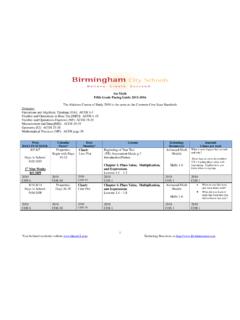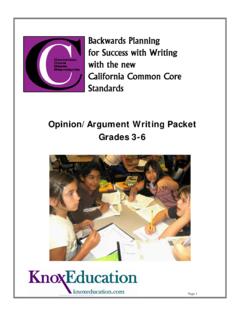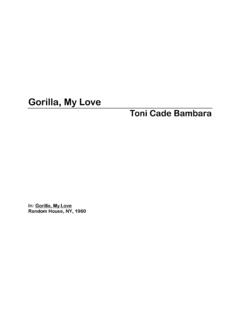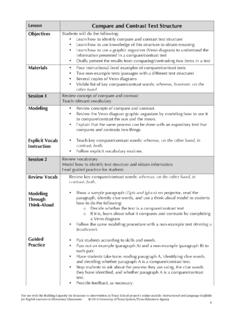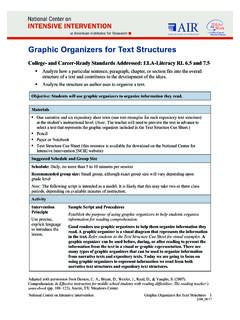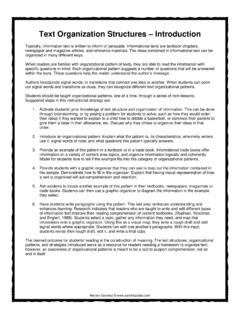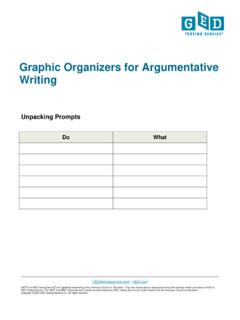Transcription of Reading Graphic Organizers - Birmingham City Schools
1 Reading Graphic Organizers For the 5th Grade Common Core Literature Standards No. Standard Description Book/Chapter for Lesson Graphic Organizer/Activity Date Standard Covered RL Quote accurately from a text when explaining what the text says explicitly and when drawing inferences from the text. RL Determine a theme of a story, drama, or poem from details in the text, including how characters in a story or drama respond to challenges or how the speaker in a poem reflects upon a topic; summarize the text. RL Compare and contrast two or more characters, settings, or events in a story or drama, drawing on specific details in the text ( , how characters interact). RL Determine the meaning of words and phrases as they are used in a text, including figurative language such as metaphors and similes. RL Explain how a series of chapters, scenes, or stanzas fits together to provide the overall structure of a particular story, drama, or poem. RL Describe how a narrator s or speaker s point of view influences how events are described.
2 RL Analyze how visual and multimedia elements contribute to the meaning, tone, or beauty of a text ( , Graphic novel, multimedia presentation of fiction, folktale, myth, poem). RL Compare and contrast stories in the same genre ( , mysteries and adventure stories) on their approaches to similar themes and topics. Planning with 5th Grade Reading Common Core Standards April Walker 2012 All of these Graphic Organizers could be used as guided practice to introduce the skills and then eventually students could draw the Organizers and charts on their own. If needed, continue to use the Organizers as an accommodation for students who need it. Thank you for purchasing my product. Visit my blog at or email me at Fonts from: graphics from: Graphic Organizers and Lesson ideas for Reading Literature Standards Quote accurately from a text when explaining what the text says explicitly and when drawing inferences from the text. Students need to learn how to quote from a text and explain what it means in their own words.
3 Drawing inferences from the quote allows them to think more deeply about the words and phrases that authors use. Learning how to explain what a quote means sets the foundation for students to do literary analysis as they get older. Practice having students explain quotes as part of their Reading Response. Have them collect words and phrases they like from a book and explain why they like them. This would also be a great standard to practice with poetry. Have students explain a line of a poem and make inferences on why the authors use the language they use. Give students an idiom or quote each week to explain in their own words. For lessons for this standard, use authors like Patricia Polacco or others who write with rich language or with deeper subject matter in their books. Check out my blog Each week as part of a Writing Inspiration post, I post a picture, quote, and poem. The quotes and poems could also be used to practice this standard. April Walker 2012 Name_____ Date_____ Book Title_____ Quote, Explain, Infer (CCS RL ) Quote + My Own Thinking = Conclusion April Walker 2012 Quote from the book: My own Thoughts on What it Means: My Conclusion: Name_____ Date_____ Book Title_____ Quote, Explain, Infer (CCS RL ) Quote from Text Copy down a quote from the text that helps you better understand the characters, events, or themes of the story.
4 In My Own Words Write what the narrator or character was saying in your own words. (I think it ) My Conclusion Draw a conclusion (or make an inference) about the characters, events, theme, or moral of the story. April Walker 2012 Sentence Stems Drawing Conclusions and Making Inferences Here are some sentence stems to help you draw a conclusion (or make an inference) about the characters, events, theme, or moral of a story: I think the character (name) is (adjective) because (give reason). I predict _____ will happen because_____. I infer that the character (name) is feeling _____ because _____. I conclude that the character (name) did this action (describe an action the character did) because (give reason). I conclude the theme of the story is _____ because (give details from the text). I infer that the moral or message of the story is _____ because (describe the lessons the character s learned or clues from their thoughts and actions). Sentence Stems Drawing Conclusions and Making Inferences Here are some sentence stems to help you draw a conclusion (or make an inference) about the characters, events, theme, or moral of a story: I think the character (name) is (adjective) because (give reason).
5 I predict _____ will happen because_____. I infer that the character (name) is feeling _____ because _____. I conclude that the character (name) did this action (describe an action the character did) because (give reason). I conclude the theme of the story is _____ because (give details from the text). I infer that the moral or message of the story is _____ because (describe the lessons the character s learned or clues from their thoughts and actions). April Walker 2012 Determine a theme of a story, drama, or poem from details in the text, including how characters in a story or drama respond to challenges or how the speaker in a poem reflects upon a topic; summarize the text. Discussing theme has a lot to do with character analysis and author s purpose. It is helpful for students to first analyze the type of text and why the author wrote the text. I really am a huge fan of the writing strategy RAFT (Role, Audience, Format, Topic).
6 Have students use RAFT as a way to analyze author s purpose in things they read as well. After analyzing author s purpose, have students analyze the characters. Discuss character traits and how we can determine character traits through a character s thoughts, feelings, and actions. As we analyze characters, we can begin to move into a deeper discussion of how characters respond to problems in a story. Have students then make a story map of the story to determine the problem and resolution of the story. From there, I would open the discussion to theme. After students have analyzed the characters and identified the problem and resolution of the story, they can begin analyzing how the characters responded to the problem. Explain that the theme of a story usually is the lesson the author wants the reader to learn. This is often rooted in the lessons the character learned in the story. April Walker 2012 Name_____ Date_____ Book Title_____ Analyzing Author s Purpose in a Text Is the author trying to persuade, inform, or entertain you in this text?
7 Give examples of why you think that is the author s purpose. Role: What is the role of the narrator? Analyzing Literary Text with RAFT Audience: Who is the audience of the text? Format: What is the format of the text ( picture book, chapter book, Graphic novel, diary, etc.)? Topic: What is the topic of the book? April Walker 2012 Name_____ Date_____ Book Title_____ Analyzing Characters in a Text Character Name _____ Describe a character below by thinking of character traits based on the character s thoughts, feelings, and actions. Character Trait: Character s Thoughts: Character s Feelings: Character s Actions: Character Trait: Character s Thoughts: Character s Feelings: Character s Actions: April Walker 2012 Name_____ Date_____ Book Title_____ Thinking about Theme Theme of the Story: Problem in the Story: Characters Response to Problem: Mood (How the Story Makes you feel): Lessons Characters Have Learned: Characters Thoughts & Feelings: Explain the theme of the story (or chapter) based on details in the text.
8 (CCS RL ): _____ _____ _____ April Walker 2012 Compare and contrast two or more characters, settings, or events in a story or drama, drawing on specific details in the text ( , how characters interact). Before you can really compare and contrast these elements of two texts , students need to be comfortable with the idea of plot. Spend a lot of time on creating plot mountains or story maps. Have students analyze the setting, characters, and events of individual stories. For ideas on lessons for setting, click on this link. This is a free resource I made for ideas on teaching setting. My goal is to create more lesson plan ideas like this one. After students have analyzed the setting, characters, and events of stories individually, have them use a Venn Diagram to compare and contrast them. You also could have students write compare/contrast papers for two chapters or stories by the same author. This would even be a good time to introduce a compare/contrast text structure.
9 Use a book like The Pain and the Great One by Judy Blume to discuss comparing and contrasting characters and this type of text structure. April Walker 2012 Name_____ Date_____ Book Title_____ Compare/Contrast Characters in a Story (CCS RL ) Character 1:_____ Character 2:_____ On the back of this sheet (or on a separate sheet of paper), write 1-2 paragraphs to compare and contrast two characters in the story, focusing on the way they interacted in the story and responded to events. Use your thoughts from the Venn Diagram above to help you. April Walker 2012 Name_____ Date_____ Book Title_____ Compare/Contrast Events in a Story (CCS RL ) On the back of this sheet (or on a separate sheet of paper), write 1-2 paragraphs to compare and contrast two events in the story. Focus on how characters responded to the events and the way the events contributed to the overall plot and problem in the story. Use your thoughts from the Venn Diagram above to help you.
10 Event 1:_____ Event 2:_____ April Walker 2012 Name_____ Date_____ Book Title_____ Compare/Contrast Settings in a Story (CCS RL ) On the back of this sheet (or on a separate sheet of paper), write 1-2 paragraphs to compare and contrast two settings in the story. Focus on how characters responded to the settings and how the settings contributed to the events and problem in the story. Use your thoughts from the Venn Diagram above to help you. Setting 1:_____ Setting 2:_____ April Walker 2012 Determine the meaning of words and phrases as they are used in a text, including figurative language such as metaphors and similes. Before I would cover this standard, I would discuss different types of figurative language. Have students create examples of similes and metaphors so they are familiar with them. Figurative Language is always a great time to discuss imagery and visualizing. If your students can visualize the comparisons, this will help them build the skills needed to make the connections.



